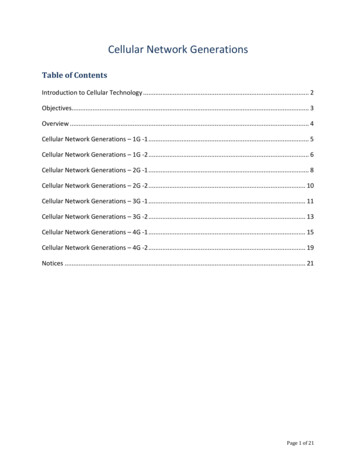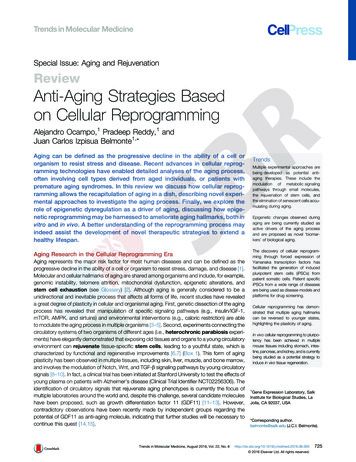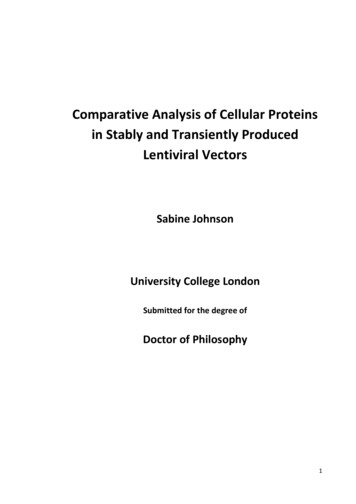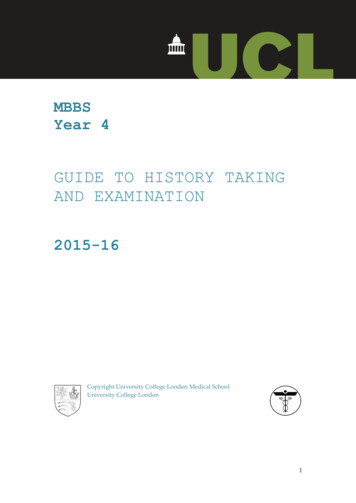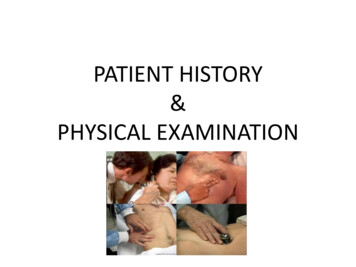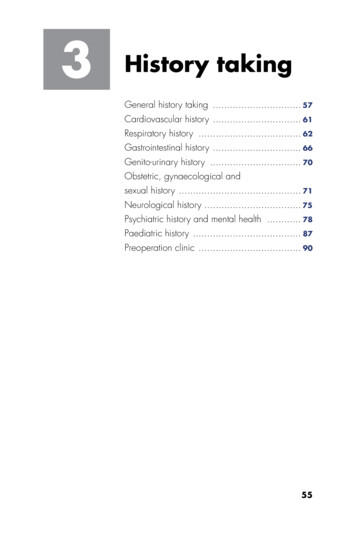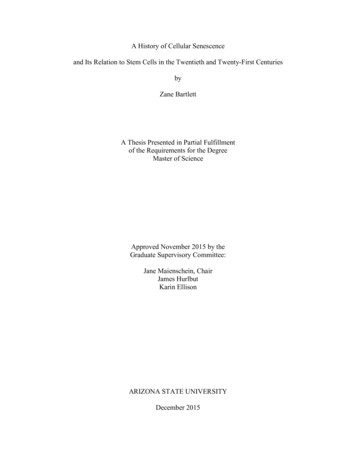
Transcription
A History of Cellular Senescenceand Its Relation to Stem Cells in the Twentieth and Twenty-First CenturiesbyZane BartlettA Thesis Presented in Partial Fulfillmentof the Requirements for the DegreeMaster of ScienceApproved November 2015 by theGraduate Supervisory Committee:Jane Maienschein, ChairJames HurlbutKarin EllisonARIZONA STATE UNIVERSITYDecember 2015
ABSTRACTResearchers in the twentieth and twenty-first centuries identify the study of theintrinsic and external factors that influence human aging as senescence. A commonlyheld belief in the year 2015 is that at least some kinds of cells can replicate over longperiods or even indefinitely, thereby meaning the cell does not undergo senescence (alsoknown as replicative senescence) and is considered immortal. This study aims to provideinformation to answer the following question: While some scientists claim they canindefinitely culture a stem cell line in vitro, what are the consequences of those culturingpractices? An analysis of a cluster of articles from the Embryo Project Encyclopediaprovides information to suggest possible solutions to some potential problems in cellculturing, recognition of benefits for existing or historical culturing practices, andidentification of gaps in scientific knowledge that warrant further research. Recentresearch suggests that hESCs, and immortalized cell lines in general, do not escape theeffects of senescence. While there exists a constant change in the practices of cellculturing, a large portion of scientists still rely on practices established before modernsenescence research: research that seems to suggest that cultured hESCs, among otherimmortal cell lines, are not truly immortal.i
ACKNOWLEDGMENTSThough many helped me complete this paper, I would be remiss if I did not firstthank my advisor, Dr. Jane Maienschein. I am deeply grateful for her continueddedication, patience, and guidance throughout the course of my academic pursuits. Thankyou for tempering justice with mercy, and thank you for inspiring me to ask the rightquestions. I could not have completed this paper without Dr. Maienschein's assistance. Iwould also like to thank the other members my committee, Dr. Karin Ellison and Dr. BenHurlbut. Both have provided valuable support, comments, and insights throughout myresearch and writing. My sincere thanks goes to colleagues and editors involved in TheEmbryo Project, who helped provide the backbone of this thesis, and who encouraged meto keep writing. I am grateful for the support I received from staff and faculty in theSchool of Life Sciences and Center for Biology and Society at Arizona State University.Lastly, I thank my parents, sisters, brothers, and extended family for their help andsupport.ii
TABLE OF CONTENTSCHAPTERPage1. INTRODUCTION . 12. IMMORTAL, MORTAL, OR BOTH? – GENERAL SENESCENCE HISTORYAND INFORMATION. 5Apoptosis and its Role in Embryonic Development . 7Leonard Hayflick (1928- ) . 14The Hayflick Limit . 22Leonard Hayflick’s 1964 Experiment, “The Limited In Vitro Lifetime of HumanDiploid Cell Strains” . 263. TELOMERES/TELOMERASE AND SENESCENCE . 32Carol Widney Greider (1961-) . 33Elizabeth Blackburn, Carol Greider and Jack Szostak's Telomere and TelomeraseExperiments (1982-1989) . 39Telomerase in Human Development . 44Telomeres and Telomerase in Cellular Aging (Senescence) . 50Paternal Sperm Telomere Elongation and its Impact on Offspring Fitness . 554. SHEEP, SENESCENCE, AND STEM CELLS – CLONING AND SCNT TO“TURN BACK THE CLOCK” . 63Keith Henry Stockman Campbell (1954-2012). 64"Sheep Cloned by Nuclear Transfer from a Cultured Cell Line" (1996), by KeithCampbell, Jim McWhir, William Ritchie, and Ian Wilmut . 73iii
CHAPTERPage"Viable Offspring Derived from Fetal and Adult Mammalian Cells" (1997), by IanWilmut et al. . 80"Human Factor IX Transgenic Sheep Produced by Transfer of Nuclei fromTransfected Fetal Fibroblasts" (1997), by Angelika E. Schnieke, et al. . 87The Roslin Institute (1993- ). 93Somatic Cell Nuclear Transfer in Mammals (1938-2013) .1005. STEM CELLS AND SENESCENCE – MODERN RESEARCH .107Induced Pluripotent Stem Cell Experiments by Kazutoshi Takahashi and ShinyaYamanaka in 2006 and 2007 .1086. CONCLUSION .115REFERENCES: .120iv
CHAPTER 1INTRODUCTIONOne objective of medical science is to prolong human life. In order to understandhow science can extend a human life, it is helpful to understand what scientistscommonly think are causes of human aging, and subsequently death. Researchers in thetwentieth and twenty-first centuries identify the study of the intrinsic and external factorsthat influence human aging as senescence. Much of the scientific research of senescencefocuses on the intrinsic and external factors of the cell in particular, as it is the basic unitof biological life forms. Therefore, cellular senescence (also known as cytogerontologyduring the 1970s and early 80s), refers to factors that cause cells to age, particularlyrelating to the capacity of a cell to replicate (Campisi).A commonly held belief in the year 2015 is that at least some kinds of cells canreplicate over long periods or even indefinitely, thereby meaning the cell does notundergo senescence (also known as replicative senescence) and is considered immortal.A cell line that does not undergo senescence is called an immortalized cell line.Immortalized cell lines can include stem cells, as well as cancer cells. Immortalized cellsthat acquire replicative immortality through various mutations are called cancer cells,whereas immortalized cells that are a normal part of development are called stem cells.Scientists define stem cells based on the following criteria (NIH):1. Stem cells can renew themselves for prolonged periods through cellular division(self-renewal)2. Stem cells give rise to other cell types in the body (differentiation)1
Stem cells are very alluring to researchers because of their potential applications inmedicine to regenerate damaged tissues and slow the human aging process.Scientists classify stem cells into two categories: adult and embryonic. The mostsought after stem cells are human embryonic stem cells (hESC), or cells from the innercell mass of a blastocyst of a human pre-implantation embryo. Adult stem cells aretypically limited to becoming only a few cell types whereas embryonic stem cells fromthe blastocyst are capable of becoming all cell types, except for extra-embryonicstructures such as the placenta. Extra-embryonic structures are derived from cells as partof the morula, which scientists consider “totipotent”, or capable of becoming all celltypes. Researchers call hESCs “pluripotent”. Some scientists claim that hESCs have“basically indefinite proliferative capacity, [and] they lend themselves as practicallyinexhaustible resource” (Zachar).While scientists claim they can indefinitely culture a stem cell line in vitro, whatare the consequences of those culturing practices? To understand such a question, and themodern definition of senescence and how it applies to immortal cell lines, it is useful toexamine what scientists thought about cells and aging in decades past. For the purposesof this research, the historical background will be limited within the timeframe of the late19th century to the year 2015. A series of articles published in The Embryo ProjectEncyclopedia can serve as a tool to help understand what scientists thought about agingand cells in the past.The Embryo Project Encyclopedia is a part of the Embryo Project at ArizonaState University. The Embryo Project Encyclopedia houses a collection of research“related to the sciences of embryology, development, and reproductive medicine, their2
legal, ethical and social contexts, and histories of those sciences and contexts” (TheEmbryo Project). Though the Embryo Project Encyclopedia is a collection of individual,independent articles, inquiring minds can examine clusters of topically related articles toprovide insights into why scientists might think the way they do, or why they mightconduct certain research. This method of examining clusters of articles seems particularlyuseful to determine how modern scientists could view research related to stem cells andaging. With the aid of Embryo Project Encyclopedia articles, this thesis aims to provideinformation to help answer the following question: What are some of the commontechniques used to acquire stem cells and what happens to immortal cell lines(particularly embryonic stem cell lines) when scientists culture them indefinitely in vitro?Chapters 2 through 5 highlight multiple methods of acquiring cell populations,including immortal cell populations. The research is grouped both chronologically andcontextually, with related articles clustered together in the same chapter. Each chapterbegins with a brief synopsis of related Embryo Project Encyclopedia articles, as well asrelevant historical information. Embryo Project Encyclopedia article titles are followedby citations to the corresponding article. For convenience, the full articles are included inthis thesis. More specifically, chapter 2 examines general senescence history andinformation, chapter 3 examines research on telomeres and telomerase, chapter 4examines research on cloning, and chapter 5 examines a modern cell culturing practice.Chapter 6 attempts to give answers to the driving question of the thesis. Theanswers can come in part from examining the work of scientists from the 19th to 21stcenturies. Such an examination will provide recognition of possible benefits anddetriments for existing or historical culturing practices, identification of potential gaps in3
scientific knowledge that warrant further research, and the formulation of possiblesolutions to potential problems.4
CHAPTER 2IMMORTAL, MORTAL, OR BOTH? – GENERAL SENESCENCE HISTORY ANDINFORMATIONHistorians often accredit August Weismann as one of the earliest to identify apossible link between cell biology and aging in the late nineteenth century. In search ofan evolutionary explanation for aging, Weismann theorized that an organism’s lifespanwas determined by the number of generations a cell could produce. However, Weismannwas unable to provide substantial empirical evidence to support his claims (Kirkwood).Weismann was not the only researcher in the early 1900s to explore the idea ofaging in cells. Charles Sedgewick Minot also studied senescence in his work withembryos and human anatomy. In his 1908 book, Minot defined senescence as a decreaseof power of cell growth, which occurs every time a cell divides.In 1912, the Nobel Laureate Alexis Carrel published an experiment that gaveevidence to suggest that the power of cell growth does not diminish with time whencultivated in vitro, or outside of the body. Immortality, according to Carrel, was anintrinsic characteristic of all cells. With further research, Carrel claimed that “permanentlife” in vitro was possible if researchers paid special attention to maintain glassware, andif correct nutrients were given to the cultured cells (Carrel, Jiang, Landecker). ThoughCarrel’s hypothesis suggested immortality as an internal factor in cells, the causes ofaging were external. Once Carrel published and propagated his research, Weismann andMinot’s theories were quickly overshadowed. For many years, the majority of biologistsconsidered Carrel’s experiments and his interpretations as fact, despite repeated failuresin attempts to reproduce Carrel’s results.5
As a result of Carrel’s work, other scientists attempted to establish “immortal”cell lines, with hopes of achieving immortality for human cells. Among the eagerscientists was George Gey, at John’s Hopkins University. In 1951, Gey obtained andcultured cells from Henrietta Lacks, a woman suffering from cervical cancer. Scientistsnamed the cells HeLa, after the patient’s name. His team dubbed the resulting cellcultures immortal in the same way that Alexis Carrel’s cell lines were immortal, as theywere able to propagate the human cell line for over a year without any signs that the cellswere subject to senescence (Scherer). HeLa cells continue to be widely used in researchto develop vaccines and study human disease.In 1961, a scientist named Leonard Hayflick observed a phenomenon in humancells he cultured in vitro. He noted that the cells ceased replication after forty to sixtydivisions, or cell population doublings (Hayflick). Such an observation was contradictoryto Carrel’s commonly accepted notion of cell biology, and cell cultures such as HeLa.Hayflick experimented further in 1965, and concluded that Carrel’s theory of senescencewas incorrect, as it appeared that some cells were not capable of replicating indefinitely.He also hypothesized that there was a factor within cells that caused the cessation inreplication. Hayflick rigorously researched and reported his findings, and soon Carrel’shypothesis of universal cell immortality was disregarded. As a result of Hayflick’sexperiments, Sir Macfarlane Burnet named the limited capacity for cellular division theHayflick Limit in 1974.During the 1950s, scientists were also researching the causes of cell death. In1951, Alfred Glücksmann observed a phenomenon of cell death in embryos, which heclaimed was necessary for tissue and organ formation. It was a phenomenon that John6
Kerr and his colleagues at the University of Aberdeen, in Aberdeen, Scotland would callapoptosis in 1972.To begin understanding the mechanics of life, scientists often asked why or howlife ended. The following articles from the Embryo Project Encyclopedia are glimpsesinto how scientists in the 19th and 20th centuries viewed death, particularly in terms ofthe death and lifespan of cells.Apoptosis and its Role in Embryonic DevelopmentBartlett, Zane. “Apoptosis and its Role in Embryonic Development”. (Citation pending publication in theEmbryo Project Encyclopedia)Apoptosis is an essential mechanism in embryonic development and it is a formof programmed cell death, which occurs naturally in organisms. The process of apoptosisis different from cell necrosis, which usually occurs uncontrolled after infection orspecific trauma. As rapid cell proliferation occurs during development, certain cellsundergo apoptosis, which is necessary for many stages in development, including neuraldevelopment, reduction in oocytes at birth, as well as the shaping of digits and vestigialorgans in humans and other animals (Barres, Jacobson, Reynaud). Karl Vogt firstobserved the phenomenon of apoptosis in 1842 while studying the midwife toad (Alytesobstetricans) in Neuchâtel, Switzerland, but little effort occurred to understand it forabout a century. Alfred Glücksmann researched the phenomenon in 1951 while workingat the Strangeways Research Laboratory in Cambridge, England, and published a review,claiming it was important to embryological development. In 1972, John Kerr and hiscolleagues at the University of Aberdeen, in Aberdeen, Scotland, claimed that apoptosis7
was the same process in body cells, called somatic cells, as it was during development ofembryological cells. Kerr and his colleagues coined the term apoptosis, after the Greekwords apo and ptosis, which translates to falling, or dropping off. Sydney Brenner, H.Robert Horvitz and John E. Sulston received the Nobel Prize in Physiology or Medicinein 2002 for their work on the genetic regulation of organ development and programmedcell death. As researchers continue to map out the processes of cell lineages before andafter embryonic development, they may also learn new ways to reduce or promote celldeath, which can be important in preventing diseases such as Alzheimer’s or cancer.The phenomenon of apoptosis was first observed by Karl Vogt in in Neuchâtel,Switzerland, in 1842, however Vogt did not call the phenomenon apoptosis. Vogt noticedin midwife toad embryos that cells in the notochord, a cartilaginous skeletal structure,disappeared and were replaced by cells of the vertebrae (Clark). Though Vogtdocumented the disappearance of cells during development, he did not focus his researchon the disappearances (Vogt). Because of that lack of focus, the phenomenon was notgiven very much attention until 1885 when Walther Flemming, who worked at theUniversity of Kiel, Kiel, Germany, used more advanced staining techniques of the cellnucleus to observe what he called chromatolysis, the distinct diminishing of nuclearmaterial in dying cells (Flemming). Chromatolysis is part of the process of apoptosis, butFlemming’s research was forgotten until the developmental biologist, AlfredGlücksmann, published a review on cell death literature in 1951 while working at theStrangeways Research Laboratory in Cambridge, England (Peter).Glücksmann’s embryological review on cell death influenced general acceptanceof apoptosis as an essential part of embryonic development. He hypothesized that for an8
organism to grow and develop, cell death must occur. At the time of Glücksmann’sreview, many scientists mistook dead cells observed under a microscope as metabolicbyproducts of cells undergoing mitosis, or cellular replication. Glücksmann attempted todispel these beliefs by presenting evidence from past embryological research that pointedto planned cell death as an aspect of normal development. Glücksmann’s findings wentlargely unnoticed for a period of over twenty years. However, John Kerr, Andrew Wyllie,and Alastair Currie, pathologists working at the University of Aberdeen, Aberdeen,Scotland, referenced Glücksmann’s review as motivation to develop their own research in1972.Kerr had first studied cell death in 1965 when he noticed atrophy, or shrinkage, inrat liver cells under an electron microscope. Kerr noticed that the shrinkage was distinctfrom necrosis due to trauma, which normally causes the cell to rupture and release itscontents, so Kerr decided to study it further with Wyllie and Currie. They noticedcommon patterns involved in cell death, as recorded in previous experiments andreviews, including Glücksmann’s work. Kerr and his team felt there should be a specificname for what they considered to be programmed cell death, a concept they understoodfrom research conducted by Richard Lockshin and Carroll Williams at St. John’sUniversity, New York City, New York, in 1964. Kerr and his colleagues coined the termfor the new form of programmed cell death, apoptosis. They claimed that cell death fromapoptosis was not accidental, and that it followed the same pattern in developing ce
scientists was George Gey, at John’s Hopkins University. In 1951, Gey obtained and cultured cells from Henrietta Lacks, a woman suffering from cervical cancer. Scientists named the cells HeLa, after the patient’s name. His team dubbed the resulting cell cultures immortal in the same w
